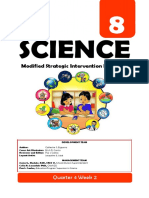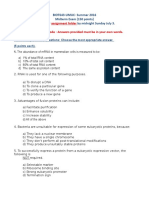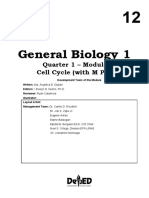Assignment Problem Solving Chapter 2
Uploaded by
Madalyn StarkeyAssignment Problem Solving Chapter 2
Uploaded by
Madalyn StarkeyAssignment Problem Solving 1 (Chapter 2)
Please solve the following questions. Show all your steps to solve the problems
clearly. Take a picture and upload it on D2L in the assignment folder. You can also
work digitally and upload a word file or pdf file.
1. The amount of DNA per cell of a particular species is measured in cells found at
various stages of meiosis, and the following amounts are obtained:
Amount of DNA per cell in picograms (pg)
_____4 pg _____8 pg _____16 pg
Match the amounts of DNA above with the corresponding stages of meiosis (a
through f, below). You may use more than one stage for each amount of DNA.
Explain your reasoning.
Stage of meiosis
a. G1
b. Prophase I
c. G2
d. Following telophase II and cytokinesis
e. Anaphase I
f. Metaphase II
2. List and briefly describe three major cell cycle checkpoints. For each checkpoint,
predict the consequences if the checkpoint fails to work properly.
3. The Rhesus monkey (Macaca mulatta) is a sexually-reproducing, diploid animal.
During mitosis, the maximum number of chromatids observed is 84.
a. How many PAIRS of homologous chromosomes does this monkey
species have?
________
b. What is the haploid content for Rhesus monkey?
________
c. What should be the maximum number of chromatids observed during
meiosis?
4. A typical somatic cell from a badger, which is a diploid, sexually reproducing
animal, contains a total of 32 chromosomes. Gametogenesis in badgers is similar
to humans.
a. What is the genome size for the badger in terms of chromosome number?
b. How many DNA molecules would be found in a secondary oocyte before
dividing?
c. How many chromosomes would be found in a cell at metaphase?
d. How many DNA molecules should be in a tetraploid liver cell from the
badger?
5. Describe the changing role of cohesin during the mitotic cell cycle. Explain the
importance of regulation of cohesin activity to normal cell division.
6. A biologist examines a series of cells and counts 160 cells in interphase, 20 cells
in prophase, 6 cells in prometaphase, 2 cells in metaphase, 7 cells in anaphase
and 5 cells in telophase. If the complete cell cycle requires 24 hours, what is the
average duration of M phase in these cell
7. All of the following cells, shown in various stages of mitosis and meiosis, come
from the same rare species of plant.
a. What is the diploid number of chromosomes in this plant?
b. Give the names of each stage of mitosis or meiosis shown.
c. Give the number of chromosomes and number of DNA molecules per cell
present at each stage.
You might also like
- Hourglass Workout Program by Luisagiuliet 276% (21)Hourglass Workout Program by Luisagiuliet 251 pages
- Knee Ability Zero Now Complete As A Picture Book 4 PDF Free94% (68)Knee Ability Zero Now Complete As A Picture Book 4 PDF Free49 pages
- The Hold Me Tight Workbook - Dr. Sue Johnson100% (16)The Hold Me Tight Workbook - Dr. Sue Johnson187 pages
- Livingood, Blake - Livingood Daily Your 21-Day Guide To Experience Real Health77% (13)Livingood, Blake - Livingood Daily Your 21-Day Guide To Experience Real Health260 pages
- Shortcut To Shred Ebook Revised 9-9-2015 PDF86% (7)Shortcut To Shred Ebook Revised 9-9-2015 PDF15 pages
- Anastasia: The New Broadway Musical (LIBRETTO)94% (174)Anastasia: The New Broadway Musical (LIBRETTO)117 pages
- COSMIC CONSCIOUSNESS OF HUMANITY - PROBLEMS OF NEW COSMOGONY (V.P.Kaznacheev,. Л. V. Trofimov.)94% (212)COSMIC CONSCIOUSNESS OF HUMANITY - PROBLEMS OF NEW COSMOGONY (V.P.Kaznacheev,. Л. V. Trofimov.)212 pages
- (Psilocybin) How To Grow Magic Mushrooms A Simple Psilocybe Cubensis Growing Technique PDF75% (8)(Psilocybin) How To Grow Magic Mushrooms A Simple Psilocybe Cubensis Growing Technique PDF48 pages
- Singer's Anthology Master Song and Show Index 2008 PDF37% (43)Singer's Anthology Master Song and Show Index 2008 PDF38 pages
- The 36 Questions That Lead To Love - The New York Times94% (34)The 36 Questions That Lead To Love - The New York Times3 pages
- Jeffrey Epstein39s Little Black Book Unredacted PDF75% (12)Jeffrey Epstein39s Little Black Book Unredacted PDF95 pages
- Molecular Biology of The Cell, Sixth Edition Chapter 17: THE CELL CYCLE100% (2)Molecular Biology of The Cell, Sixth Edition Chapter 17: THE CELL CYCLE31 pages
- Synthetic Biology, A Primer, Imperial College PressNo ratings yetSynthetic Biology, A Primer, Imperial College Press4 pages
- O Level Biology Practice Questions And Answers: Heredity And Molecular GeneticsFrom EverandO Level Biology Practice Questions And Answers: Heredity And Molecular GeneticsNo ratings yet
- BIOL 182: Biology II Assignment 3 - Cell Division, Genetics and Molecular BiologyNo ratings yetBIOL 182: Biology II Assignment 3 - Cell Division, Genetics and Molecular Biology7 pages
- Lesson Notes: Biology 4G Chapter 5: Cell DivisionNo ratings yetLesson Notes: Biology 4G Chapter 5: Cell Division26 pages
- Science-8 Q4 Week-2 Lesson-2 Cell-DivisionNo ratings yetScience-8 Q4 Week-2 Lesson-2 Cell-Division17 pages
- MississippiBiologyTestStudyOutline2018-1_3_1No ratings yetMississippiBiologyTestStudyOutline2018-1_3_122 pages
- Biotechnology-Entry Test 2024 (Hakhakhi Maphupha)No ratings yetBiotechnology-Entry Test 2024 (Hakhakhi Maphupha)8 pages
- What is Life A Guide to Biology 3rd Edition Phelan Test Bank pdf download100% (1)What is Life A Guide to Biology 3rd Edition Phelan Test Bank pdf download52 pages
- 2366364-CLASS 11 - BIOLOGY - CELL CYCLE AND CELL DIVISION - WS WITH ANS - AGNESNo ratings yet2366364-CLASS 11 - BIOLOGY - CELL CYCLE AND CELL DIVISION - WS WITH ANS - AGNES7 pages
- Class Xi Biology Periodic Assesment Iii Examination Question Paper Acy 2023-24 Set-1No ratings yetClass Xi Biology Periodic Assesment Iii Examination Question Paper Acy 2023-24 Set-110 pages
- Worksheet - Preparation For An Entry TestNo ratings yetWorksheet - Preparation For An Entry Test3 pages
- S5-District Theory Biology 2nd Term Exam s5 2024100% (1)S5-District Theory Biology 2nd Term Exam s5 20248 pages
- Complete Download of Test Bank for Concepts of Genetics 12th by Klug Full Chapters in PDF DOCX100% (4)Complete Download of Test Bank for Concepts of Genetics 12th by Klug Full Chapters in PDF DOCX33 pages
- Inter-material-Istyearem-botany-unit v Cell Cycle and Cell Division 11No ratings yetInter-material-Istyearem-botany-unit v Cell Cycle and Cell Division 118 pages
- Multiple Choice Review - Mitosis & MeiosisNo ratings yetMultiple Choice Review - Mitosis & Meiosis12 pages
- Class 12 Biology Zoology EM Chapter 5. Molecular Genetics Question Bank by Rana Sakthi Durga, Puducherry.100% (1)Class 12 Biology Zoology EM Chapter 5. Molecular Genetics Question Bank by Rana Sakthi Durga, Puducherry.2 pages
- Instant Download Full Computational Systems Biology second edition Roland Eils PDF All Chapters100% (4)Instant Download Full Computational Systems Biology second edition Roland Eils PDF All Chapters37 pages
- NCERT - Solutions-Class8 - Reproduction in Animals ScienceNo ratings yetNCERT - Solutions-Class8 - Reproduction in Animals Science6 pages
- 2 Chapin Principles of Terrestrial Ecology100% (1)2 Chapin Principles of Terrestrial Ecology537 pages
- Q Sexual Reproduction Organism&Client Opera&Hs Ypy&SourceNo ratings yetQ Sexual Reproduction Organism&Client Opera&Hs Ypy&Source15 pages
- 12th Bio Zoology EM One Marks Question Paper English Medium PDF DownloadNo ratings yet12th Bio Zoology EM One Marks Question Paper English Medium PDF Download72 pages
- Biology CP Ch 11 Cell Growth and DivisionNo ratings yetBiology CP Ch 11 Cell Growth and Division41 pages
- From Wikipedia, The Free Encyclopedia: (1) (2) :glossaryNo ratings yetFrom Wikipedia, The Free Encyclopedia: (1) (2) :glossary25 pages
- Cell Commitment, Specification and DeterminationNo ratings yetCell Commitment, Specification and Determination46 pages























































































































